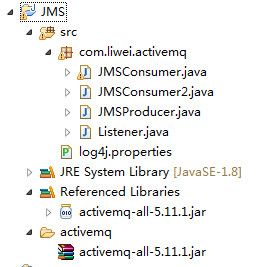开始学习 ActiveMQ(1)
package com.liwei.activemq;
import javax.jms.Connection;
import javax.jms.ConnectionFactory;
import javax.jms.Destination;
import javax.jms.JMSException;
import javax.jms.MessageProducer;
import javax.jms.Session;
import javax.jms.TextMessage;
import org.apache.activemq.ActiveMQConnection;
import org.apache.activemq.ActiveMQConnectionFactory;
/** * 消息生产者 * @author Administrator * */
public class JMSProducer {
// 默认的连接用户名
private static final String USERNAME = ActiveMQConnection.DEFAULT_USER;
// 默认的密码
private static final String PASSWORD = ActiveMQConnection.DEFAULT_PASSWORD;
// 默认的连接地址
private static final String BROKERURL = ActiveMQConnection.DEFAULT_BROKER_URL;
// 发送消息的数量
private static final int SENDNUM = 10 ;
public static void main(String[] args) {
// 连接工厂
ConnectionFactory connectionFactory = null;
// 连接
Connection connection = null;
// 会话:接受或者发送消息的线程
Session session =null;
// 消息的目的地
Destination destination = null;
// 消息的生产者
MessageProducer messageProducer = null;
// 实例化连接工厂
connectionFactory = new ActiveMQConnectionFactory(JMSProducer.USERNAME, JMSProducer.PASSWORD, JMSProducer.BROKERURL);
try {
// 通过连接工厂获取连接
connection = connectionFactory.createConnection();
// 启动连接
connection.start();
// 创建 Session ,开启事务
session = connection.createSession(Boolean.TRUE, Session.AUTO_ACKNOWLEDGE);
// 创建消息队列
destination = session.createQueue("FirstQueue1");
// 创建消息生产者
messageProducer = session.createProducer(destination);
// 发送消息
sendMessage(session, messageProducer);
session.commit();
} catch (JMSException e) {
e.printStackTrace();
} finally{
try {
if(connection!=null){
connection.close();
}
} catch (JMSException e) {
e.printStackTrace();
}
}
}
/** * 创建一个私有的方法,用于发送消息 * @param session * @param messageProducer * @throws JMSException */
private static void sendMessage(Session session,MessageProducer messageProducer) throws JMSException{
TextMessage message = null;
for (int i = 0; i < JMSProducer.SENDNUM; i++) {
message = session.createTextMessage("ActiveMQ 发送的消息:" + i);
System.out.println("发送消息:" + "ActiveMQ 发送的消息:" + i);
messageProducer.send(message);
}
}
}
2、创建消息消费者(使用直接 receive 的方式)
注意:消费者的消费线程会阻塞,所以不要使用 finally 块。
使用直接Receive 方式。
(1)Session.AUTO_ACKNOWLEDGE。当客户成功的从receive 方法返回的时候,或者从MessageListener.onMessage
方法成功返回的时候,会话自动确认客户收到的消息。
(2)Session.CLIENT_ACKNOWLEDGE。客户通过消息的acknowledge 方法确认消息。需要注意的是,在这种模
式中,确认是在会话层上进行:确认一个被消费的消息将自动确认所有已被会话消费的消息。例如,如果一
个消息消费者消费了10 个消息,然后确认第5 个消息,那么所有10 个消息都被确认。
(3)Session.DUPS_ACKNOWLEDGE。该选择只是会话迟钝第确认消息的提交。如果JMS provider 失败,那么可
能会导致一些重复的消息。如果是重复的消息,那么JMS provider 必须把消息头的JMSRedelivered 字段设置
为true。
package com.liwei.activemq;
import javax.jms.Connection;
import javax.jms.ConnectionFactory;
import javax.jms.Destination;
import javax.jms.JMSException;
import javax.jms.MessageConsumer;
import javax.jms.Session;
import javax.jms.TextMessage;
import org.apache.activemq.ActiveMQConnection;
import org.apache.activemq.ActiveMQConnectionFactory;
/** * 消息的消费者 * @author Administrator * */
public class JMSConsumer {
// 默认的连接用户名
private static final String USERNAME = ActiveMQConnection.DEFAULT_USER;
// 默认的密码
private static final String PASSWORD = ActiveMQConnection.DEFAULT_PASSWORD;
// 默认的连接地址
private static final String BROKERURL = ActiveMQConnection.DEFAULT_BROKER_URL;
public static void main(String[] args) {
// 连接工厂
ConnectionFactory connectionFactory = null;
// 连接
Connection connection = null;
// 会话:接受或者发送消息的线程
Session session =null;
// 消息的目的地
Destination destination = null;
// 消息的生产者
MessageConsumer messageConsumer = null;
// 实例化连接工厂
connectionFactory = new ActiveMQConnectionFactory(USERNAME, PASSWORD, BROKERURL);
try {
// 通过连接工厂获取连接
connection = connectionFactory.createConnection();
// 启动连接
connection.start();
// 创建 Session ,开启事务
session = connection.createSession(Boolean.FALSE, Session.AUTO_ACKNOWLEDGE);
// 创建消息队列(和消息生产者方一定要一致)
destination = session.createQueue("FirstQueue1");
/** * 以上都和创建消息生产者一样 */
// 获得消息消费者
messageConsumer = session.createConsumer(destination);
TextMessage textMessage =null;
while(true){
textMessage = (TextMessage) messageConsumer.receive(100000);// 以毫秒为单位
if(textMessage!=null){
System.out.println("接受到的消息是:" + textMessage.getText());
}else{
break;
}
}
// 这里发生了阻塞
} catch (JMSException e) {
e.printStackTrace();
} /*finally{ try { if(connection!=null){ connection.close(); } } catch (JMSException e) { e.printStackTrace(); } }*/
}
}
3、使用监听的方式(最佳实践)
(1)创建一个实现了 MessageListener 接口的类
package com.liwei.activemq;
import javax.jms.JMSException;
import javax.jms.Message;
import javax.jms.MessageListener;
import javax.jms.TextMessage;
/** * 使用Listener 监听方式是最佳实践 * 消息监听 * @author Administrator * */
public class Listener implements MessageListener{
@Override
public void onMessage(Message message) {
/*TextMessage textMessage = (TextMessage)message; System.out.println("收到的消息是:" + textMessage);*/
try {
System.out.println("收到的消息:"+((TextMessage)message).getText());
} catch (JMSException e) {
e.printStackTrace();
}
}
}
package com.liwei.activemq;
import javax.jms.Connection;
import javax.jms.ConnectionFactory;
import javax.jms.Destination;
import javax.jms.JMSException;
import javax.jms.MessageConsumer;
import javax.jms.Session;
import org.apache.activemq.ActiveMQConnection;
import org.apache.activemq.ActiveMQConnectionFactory;
/** * 消息的消费者 * @author Administrator * */
public class JMSConsumer2 {
// 默认的连接用户名
private static final String USERNAME = ActiveMQConnection.DEFAULT_USER;
// 默认的密码
private static final String PASSWORD = ActiveMQConnection.DEFAULT_PASSWORD;
// 默认的连接地址
private static final String BROKERURL = ActiveMQConnection.DEFAULT_BROKER_URL;
public static void main(String[] args) {
// 连接工厂
ConnectionFactory connectionFactory = null;
// 连接
Connection connection = null;
// 会话:接受或者发送消息的线程
Session session =null;
// 消息的目的地
Destination destination = null;
// 消息的生产者
MessageConsumer messageConsumer = null;
// 实例化连接工厂
connectionFactory = new ActiveMQConnectionFactory(JMSConsumer2.USERNAME, JMSConsumer2.PASSWORD, JMSConsumer2.BROKERURL);
try {
// 通过连接工厂获取连接
connection = connectionFactory.createConnection();
// 启动连接
connection.start();
// 创建 Session ,开启事务
session = connection.createSession(Boolean.FALSE, Session.AUTO_ACKNOWLEDGE);
// 创建消息队列(和消息生产者方一定要一致)
destination = session.createQueue("FirstQueue1");
/** * 以上都和创建消息生产者一样 */
// 获得消息消费者
messageConsumer = session.createConsumer(destination);
// 注册消息监听
messageConsumer.setMessageListener(new Listener());
} catch (JMSException e) {
e.printStackTrace();
} /*finally{ try { if(connection!=null){ connection.close(); } } catch (JMSException e) { e.printStackTrace(); } }*/
}
}


